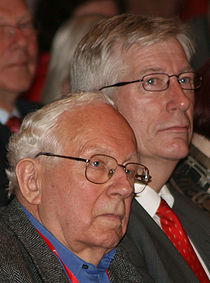The chorus of protests over construction of large power lines around the scenic Hardanger Fjord is raising its pitch. An organized protest march is planned for August 14, while a veteran Labour Party politician is urging Norway’s Labour-led government to opt for a new power line route that won’t ruin the fjord landscape.

Per Kleppe, a respected economist who served as Norway’s finance minister from 1973-1979, emerged from retirement to take a stand on the Hardanger power line debate. Writing in newspaper Dagens Næringsliv (DN) on Wednesday, the 87-year-old Kleppe claimed the government “must resist the pressure” from state power provider Statnett.
Kleppe thinks the citizens of Bergen can get the power they need, and the scenic Hardanger Fjord area can be saved from the offensive power lines and masts, if they’re moved just north of the currently proposed route.
“No community wants to get big power lines running through their area,” Kleppe wrote in DN. But he doesn’t think the communities in the mountains north of Hardanger will react as negatively as those now targeted, which fear the environment, their scenery and tourism business will be irreparably damaged.
‘Lacking environmental consideration’
Kleppe wrote that he accepts the government’s decision that underground and underwater power lines would be risky, difficult to repair and far more expensive than the overhead lines they approved just before the summer holidays began.

“But I don’t agree that the power lines should be placed where Statnett has proposed, with the destructive environmental effects that would have,” Kleppe wrote. He supports power lines that would run from Sima via Evanger, calling Statnett’s objections to that route “technical” and lacking consideration for the environment.
Kleppe’s voice is likely to be heard within the Labour Party, and others also advocate moving the power lines to the north if they must be built at all. A professor at Norway’s technical university NTNU in Trondheim also suggests in DN that merely moving the route six to seven kilometers farther from the fjord and parallel with the current route would be much less offensive to the landscape.
Civil disobedience
Meanwhile, an organized protest march against the project is set to begin on August 14 as a family-oriented hike, but may result in activists chaining themselves together along the route from Sjusete in the west to Soldal in the east.
“This is a popular hiking area which will be damaged by the power lines,” Audun Klyve Gulbrandsen, project leader of Bevar Hardanger (Protect Hardanger), told newspaper Aftenposten. His group was formed last fall to coordinate opposition to the power lines on a national basis, while another group, Folkeaksjonen i Hardanger, is more local in nature.
Other demonstrations are planned before construction begins in the autumn, with civil disobedience expected, but Klyve Gulbrandsen said everyone who registers with his group must refrain from violence and any sort of vandalism or sabotage. Around 1,700 persons already have signed up to work for the group.
The mayor of Granvin, Jan Ivar Rødland of the Labour Party, leads the local group and has invited Prime Minister Jens Stoltenberg to come visit. Stoltenberg has said he understands the opposition to power lines, but calls them necessary to avoid power shortages in Bergen.
Rødland hasn’t received any response as yet from Stoltenberg, or anyone else in the political leadership of the ministries involved.
Views and News from Norway/Nina Berglund
Join our Forum if you’d like to comment on this story.

